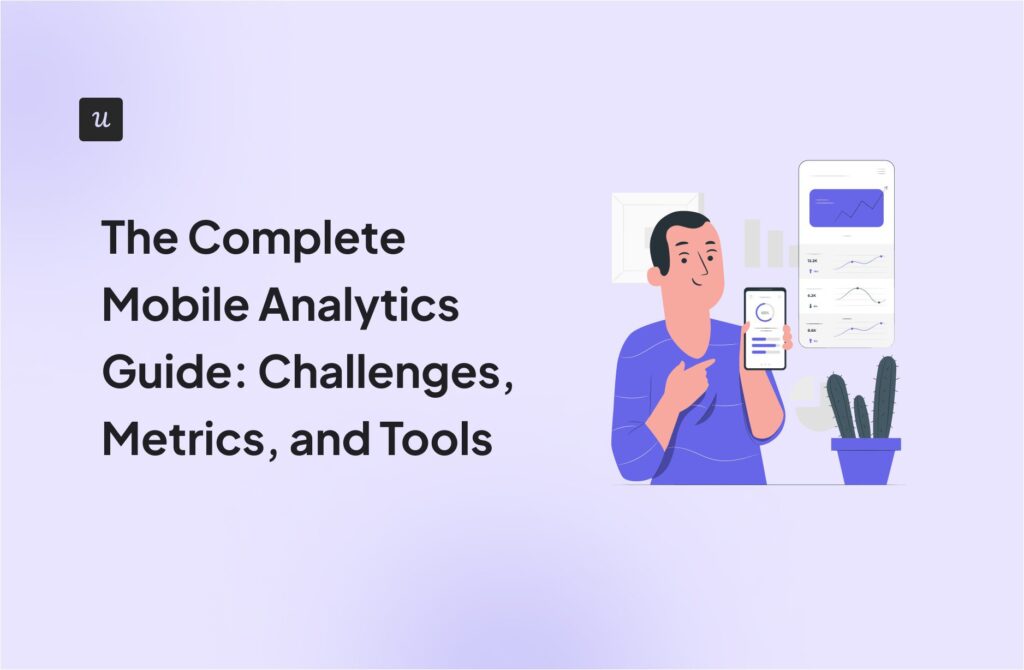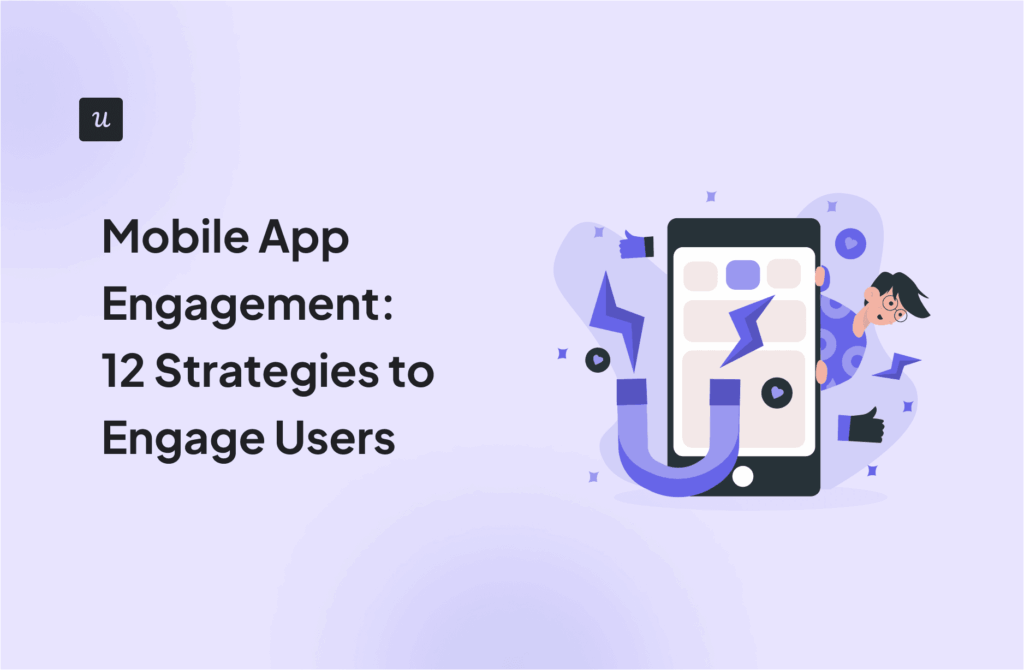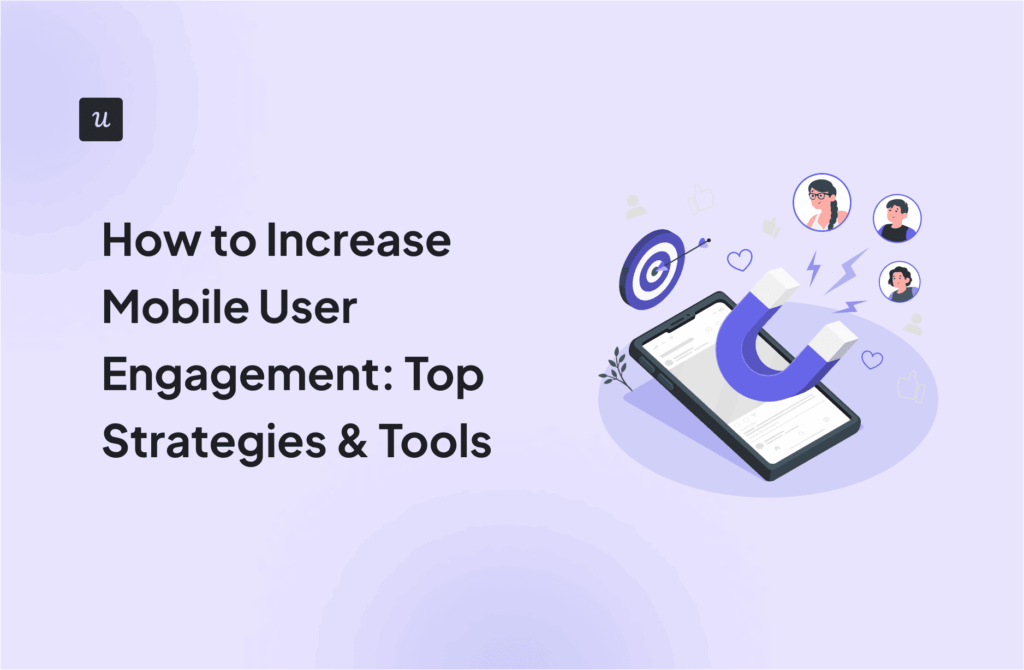What separates a good app from a great one? It’s not just the design, features, or marketing. It’s what you do with the behavior data your app collects.
And by behavior data, I don’t mean installs (that’s the easy part). I mean what happens after the download: how users navigate, what features they engage with, and where they drop off. All questions you can only answer with: Mobile app tracking.
This article breaks down what mobile app tracking is, why it matters, and methods to do it well. So you can better analyze in-app behavior, whether you’re an app developer, product manager, or part of a growth team looking to optimize every tap, swipe, and session.
Try Userpilot Now
See Why 1,000+ Teams Choose Userpilot
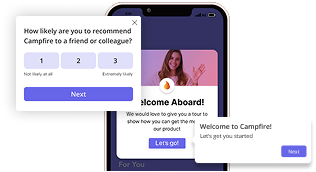
What is mobile app tracking?
Mobile app tracking captures data on how users interact with your app, including actions such as screen views, button taps, session length, and feature usage.
For example, say a user opens your app, skips the onboarding tutorial, and heads straight to the dashboard. Only to lose interest and leave without using any key feature. With app tracking, you can see that drop-off and know exactly where and why user engagement decreased.
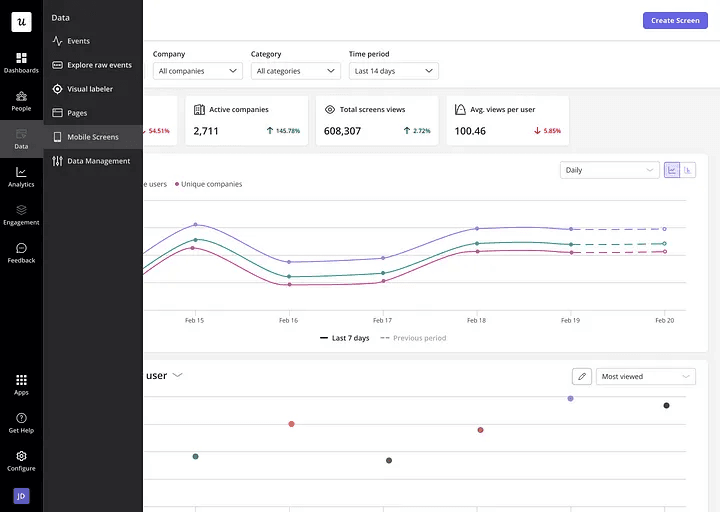
Why track in-app user behavior?
According to research, apps that track user behavior for data-driven insights see up to a 20% increase in conversion rates.
That kind of improvement comes from analyzing the data to see what’s happening inside your app, helping you answer critical questions like:
- Where are users dropping off or getting stuck?
- What features drive repeat usage?
- Which in-app behaviors correlate with long-term user retention?
Gathering all this information directly leads to better product decisions. Because now, you can:
- Improve onboarding by identifying friction points.
- Prioritize product updates, uncovering which features users value.
- Spot early signs of churn by identifying patterns in disengaged users.
Lastly, you can build more personalized experiences by segmenting mobile app analytics by persona or use case.
For instance, a casual user might only open the app once a week. Whereas a power user is active daily. Understanding these differences in how each segment interacts, whether it’s how often they use the app or which features they rely on, helps you tailor the in-app experience to meet each user’s needs.
What to track: Core in-app user behavior events
Not all user interactions are equally useful. So, for valuable insights, you need to track events that uncover user engagement, intent, and friction. Here’s a breakdown of such key in-app behaviors worth tracking, how to capture them, and what they tell you:
| What to track? | How to track it? | What to use it for? |
|---|---|---|
| Conversion actions | Sign-ups, purchases, form completions, plan upgrades | Evaluate the performance of monetization and activation funnels |
| Feature adoption | Feature discovery, usage frequency, milestones achieved (e.g., report generated) | Identify which features provide value and encourage repeat usage |
| Onboarding completion | Onboarding flows completed, tutorial dismissals, skipped steps | Improve time-to-value and reduce early drop-off |
| Session activity | Session frequency, duration, active days per week | Measure user stickiness and identify usage patterns |
| Navigation flows | Screen views, navigation paths, drop-off points | Spot confusing UX paths or bottlenecks in the user journey |
| Friction points | Failed actions, form/task abandons, rage clicks, repeated backtracks, app crashes | Uncover usage pain points causing user frustration or drop-offs |
5 Practical mobile app tracking methods for improved app performance
Random data points don’t explain user behavior. To actually improve your app, you need structured tracking methods that connect actions to outcomes. These five approaches help you do exactly that.
1. Map key events in the user journey
Mapping key events means identifying and tracking the specific in-app user actions that matter. Such as signing up, completing onboarding, using a core feature for the first time, or upgrading a plan.
How it helps:
Mapping structures your mobile app analytics. So you’re not tracking every tap or scroll, and instead focusing on the events that drive engagement and revenue.
Plus, with mapping, you can discover popular (and unpopular) navigation paths, inefficient flows, or unexpected journeys that predefined funnels might miss. For instance, you might see users skipping your “Import Data” flow and jumping straight to manual entry, suggesting confusion or low perceived value in the import feature.
How to use it:
Break the complete user journey into stages: Acquisition, Onboarding, Activation, and Retention. Assign trackable events to each stage, such as “Account Created,” during the acquisition stage.
Next, use a product analytics tool like Userpilot to tag these events, capture event data, and visualize how many users move or drop off between each stage.
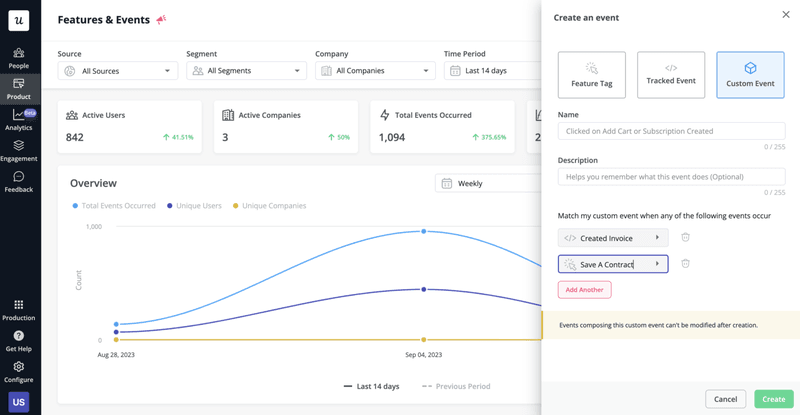
For example:
Asana, a project management tool, might track events like “Project Created” and “Project Shared.” Now, suppose a large number of users create a project but never share it. That’s a clue to revisit the sharing feature or the path leading up to it.
2. Use session replays for qualitative insights
Session replays are anonymous replays of individual user interactions with your app. So you get to see exactly what users clicked, hovered over, or hesitated on.
How it helps:
Session replays help you understand the exact user struggles that lead to frustration and drop-off.
How to use them:
Rewatching session replays is only possible with specific platforms that offer this feature, like Userpilot. These tools let you filter sessions by key segments, skip inactivity and jump to key moments, add notes, flag issues, and tag relevant teammates for quicker collaboration.
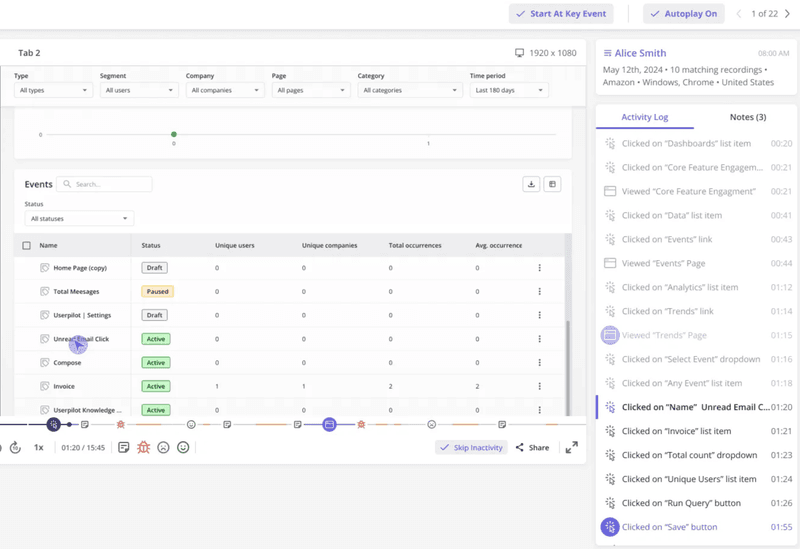
For example:
Suppose users are dropping off before finishing their dashboard setup. Session replays reveal they repeatedly open the setup page but don’t save their actions. Additionally, the heatmap shows low interaction with the “Save” button.
What does that tell you?
That the “Save” button isn’t visible enough, or it’s hidden away in a confusing layout.
3. Analyze funnels to identify drop-offs
Funnels show the steps users take to complete a key action, such as onboarding, checkout, level completion, etc.
Each step is visualized with conversion and drop-off rates, helping you see where users fall off. Userpilot makes funnel analytics easy, letting you build funnels quickly using tagged events.
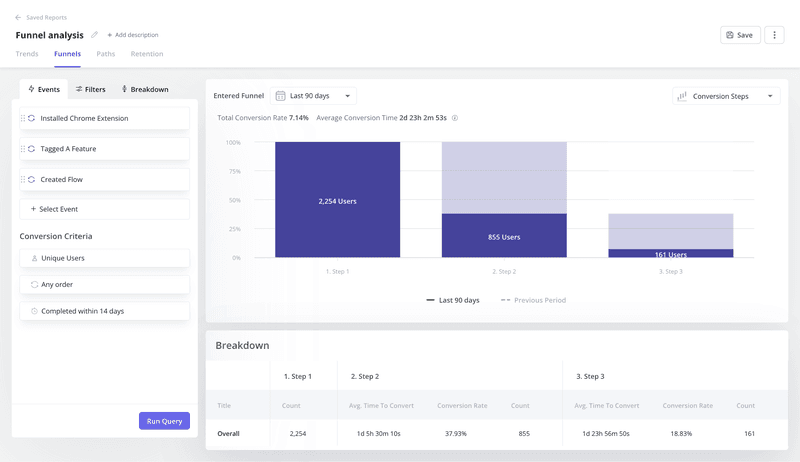
How it helps:
Funnels pinpoint exactly where users are leaving during critical flows. So, instead of guessing what’s wrong, you act on behavioral patterns.
How to use it:
- Pick a user flow to analyze: For example, trial-to-paid conversion.
- Set up the funnel: Define each funnel step as a specific in-app event.
- Identify main drop-off point: See which step has the biggest drop-off.
- Revisit previous steps: Analyze the steps before the drop-off stage to understand potential friction points, such as confusing UI, technical errors, or too many steps.
For example:
In a B2B SaaS mobile app, you might analyze the funnel from:
“Sign Up for Trial” → “Complete Onboarding Task 1” → “Invite Team Member” → “Upgrade to Paid Plan.”
A high drop-off rate after “Invite Team Member” might suggest the value proposition isn’t clear enough after initial engagement, or the pricing/upgrade path is confusing.
4. Use cohort analysis to track different user groups over time
Cohort analysis groups users based on shared traits and tracks their behavior and retention over time.
How it helps:
Cohort analysis shows how specific groups engage with your app. So you can measure retention, feature adoption, or conversion rates across time and compare how different user segments respond to in-app changes.
How to use it:
- Define your cohorts: Such as a group of users who signed up in January 2025 or customers who started their free trial this week.
- Track behavior over time: Measure retention for each group to see how behavior changes with time.
- Compare cohorts: This will tell you if recent app updates improved engagement or if one segment consistently performed better than others.
- Simplify with Userpilot: Create cohorts based on user or company properties, filter data by segments, and view retention trends over customizable periods with Userpilot.
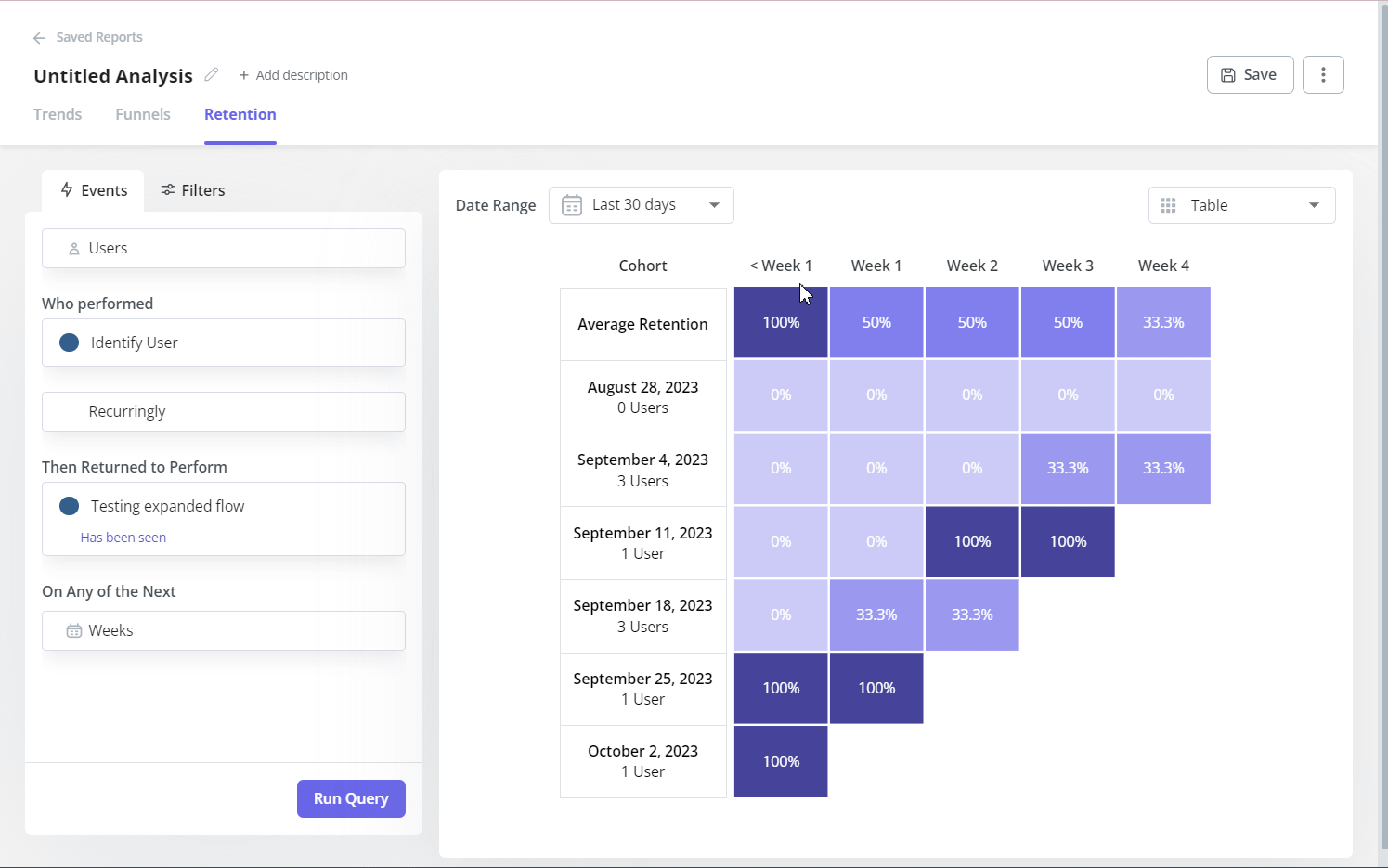
For example:
Suppose you rolled out a new onboarding experience in March. You compare the March cohort’s 30-day retention with the February cohort’s. If the March group shows higher retention and more feature usage after Day 7, it’s a sign that the new onboarding is working. If not, you revisit what changed and why the new experience didn’t land.
5. Segment users for targeted insights
User segmentation means dividing your user base into distinct groups based on user demographics, behavior, technology, or acquisition source.
| Segmentation criteria | Examples |
|---|---|
| Demographics | Age, location, language |
| Behavior | Power users, inactive users, feature adopters |
| Technology | Device type, operating system |
| Acquisition source | Organic search, paid ads, referrals |
How it helps:
Instead of looking at overall averages, segmentation offers more precise insights into how specific user groups interact, where they lose interest, and what features they use most.
How to use it:
Create segments based on attributes from the table above. Use Userpilot to help here, simplifying segment creation without any coding or manually sifting through piles of user data.
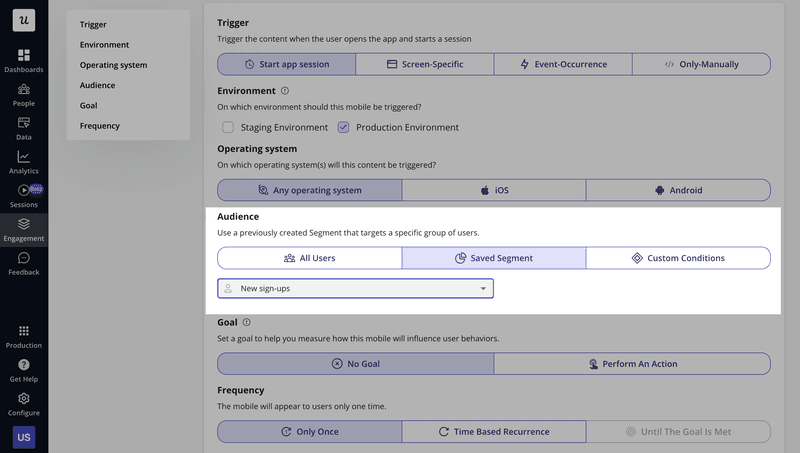
Once segmented, compare app performance metrics like engagement, retention, or feature usage across groups. Then, put these insights to work, personalizing in-app messages and experiences for each group.
For example:
You notice that users on Android mobile devices engage less with a new feature compared to iOS users. So you segment by operating system and discover the Android UI has layout inconsistencies. Fixing those with some tailored improvements is all you need to do to improve feature adoption.
👉 IMPORTANT: Handle mobile app tracking with privacy in mind
43% of users are unclear about what mobile app tracking involves, leading to misunderstandings and privacy concerns.
So, always disclose what you track and why. And make sure your tracking practices align with GDPR, CCPA, and Apple’s ATT framework (ATT). Just like Userpilot does, tracking ethically with its GDPR compliance and HIPAA and SOC 2 Type II certifications.
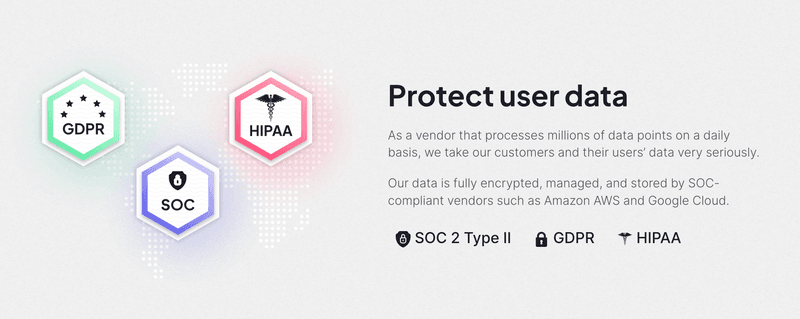
How to tailor mobile app tracking analysis for different use cases and personas
Mobile apps vary in purpose. And users vary in behavior. That means the way you track and analyze data should change depending on what your app does and who it’s for, aka the app’s use case and user persona.
1. Adapt your analysis based on the app use case
Different app use cases include subscription services, on-demand platforms, social apps, marketplaces, and productivity tools. Each use case calls for a different mobile app tracking method.
For example, for an ecommerce app, the use case demands that you focus on cart additions, checkout steps, and purchase completions.
However, the same wouldn’t make sense for subscription-based apps like SaaS or media platforms. For those, you’ll monitor trial-to-paid conversion funnels to identify friction points, churn by cohort to understand retention trends, engagement with premium features to gauge perceived value, and LTV to evaluate user profitability over time.
2. Adapt your analysis based on user persona
User personas represent different user goals, behaviors, challenges, and experience levels. That means each group uses your app differently, so looking at generalized metrics alone can hide important patterns.
Instead, analyze individually how each persona engages with your product to uncover more targeted insights.
Let’s walk through what that might look like, using Userpilot for each step.
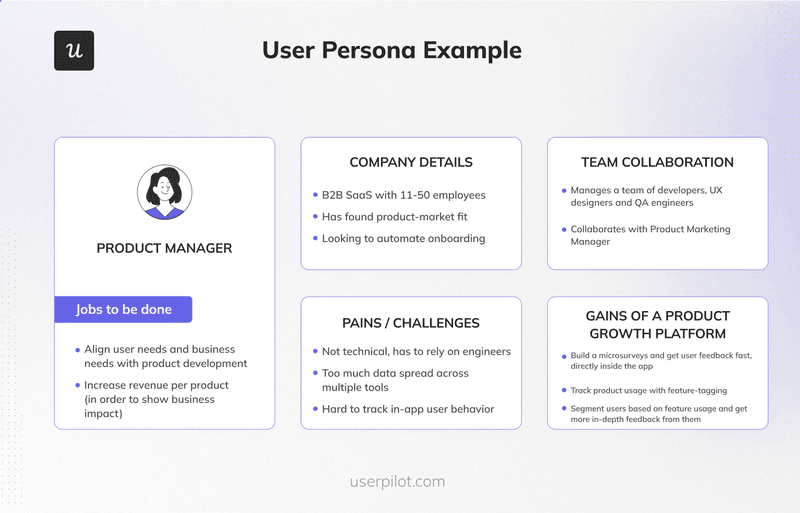
Analyze segments
Create segments in Userpilot corresponding to each persona.
For example, to build an “Active Users” segment, you can combine multiple conditions to filter for exactly the right audience. These criteria might include when the user was last seen in-app and whether they’ve completed key actions, like “Created Invoice” or “Submitted NPS.”

Compare user behavior
Next, compare behavior across segments to uncover differences in adoption rates, usage patterns, likes, dislikes, and pain points.
For instance, how does the “Power User” navigate the mobile app compared to the “New User”? Which features does each persona engage with most? Where do different personas drop off in key funnels?
Tailor the user experience
Finally, use the above insights to personalize onboarding for new users, offer advanced features to power users, or create targeted re-engagement campaigns for lapsing personas. Additionally, take the personalization a step further by localizing with Userpilot for a truly native mobile app experience.
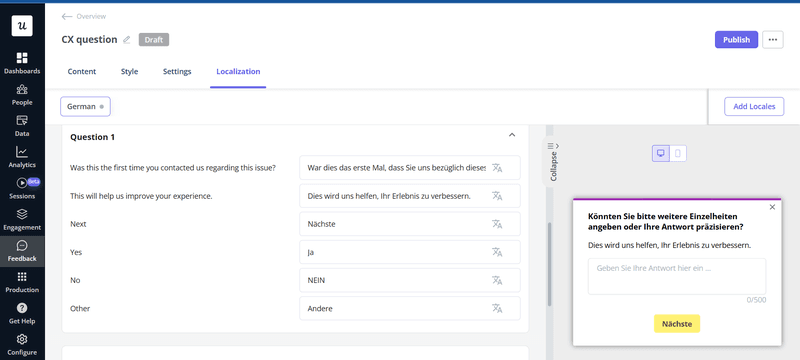
Top mobile app analytics tools
Choosing the right mobile app analytics tool depends on what you need: behavior tracking, funnel analysis, UX insights, or all of the above. Here are the three best options worth considering.
1. Userpilot
Userpilot is a multi-channel product growth platform that helps product teams track in-app behavior and personalize experiences, without any coding.
G2 rating: 4.6/5
Key features for mobile:
- Mobile onboarding: Build branded carousels and slideouts with a no-code editor to onboard users and announce new features directly in your app.
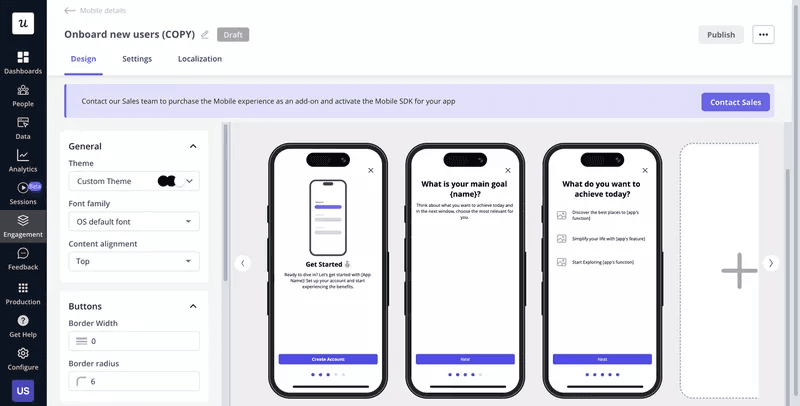
- Push notifications: Re-engage users and boost retention by sending targeted push notifications based on user behavior.
- Mobile surveys: Launch in-app surveys like NPS, CSAT, and CES to collect user feedback and improve the mobile experience.
- Mobile analytics: Track metrics like active users, activation rate, drop-offs, and top screens with customizable dashboards.
- Advanced segmentation and localization: Segment users by behavior, role, plan, device, language preference, or custom attributes to deliver personalized and localized content.
- Omnichannel engagement: Keep users engaged across mobile, desktop, and email (coming soon) for a seamless, consistent experience.

- Data security: Userpilot encrypts and securely stores data using SOC-compliant vendors like Amazon AWS and Google Cloud, and meets standards like SOC 2 Type II, GDPR, and HIPAA.
- Event and screen tracking: Monitor user actions with custom events, like button clicks or form submissions, and track screens to see where users drop off.
What customers are saying:
“One of the best features of Userpilot is its ability to not only create onboarding guides, beautiful walkthroughs, and smart tips for users but also track product features and page usage. This functionality allows us to gather insightful data, enabling us to understand user behavior, identify pain points, and continuously improve our product based on real user interactions.”
— Jatin K., Digital Adoption Professional, ServiceNow
2. Google Analytics
Google Analytics is a popular analytics service for measuring traffic and engagement across websites and mobile apps.
G2 rating: 4.5/5
Key features for mobile:
- Mobile event tracking: Every interaction is recorded as an event, offering granular insights into user behavior without relying on predefined categories.
- Cross-platform tracking: GA4 combines website and app analytics into a single dashboard, helping you understand how users interact across devices.
- Comprehensive reporting suite: Includes real-time, lifecycle, and app developer reports for monitoring traffic, engagement, revenue, and behavior across the entire app journey.
- Performance monitoring: Tracks key usage metrics like session duration, popular screens, and engagement trends.
- Privacy compliance: Automatically anonymizes IP addresses and limits data retention to 14 months to meet GDPR privacy standards.

Note: Custom event tracking requires manual setup via Google Tag Manager, which can be time-consuming and complex.
3. UXCam
UXCam is a mobile analytics platform for tracking user behavior across your app.
G2 rating: 4.6/5
Key features for mobile:
- Heatmaps: Highlight popular and ignored app elements and discover usage patterns with visual insights into user behavior.
- Session replays: Watch real user interactions within your app to identify pain points and understand drop-offs.
- Retention analytics: Detect churn risks early, find which paths lead to repeat engagement, and visualize cohort trends.
- Funnel analytics: Build funnels for any conversion action and compare funnel performance across groups or devices to find user segments with low conversion rates.
- Autocapture: Automatically capture all in-app user interactions without having to manually set up event tracking.
- Segmentation: Choose from pre-built segments or build custom segments for a deeper analysis of usage trends and churn signals.
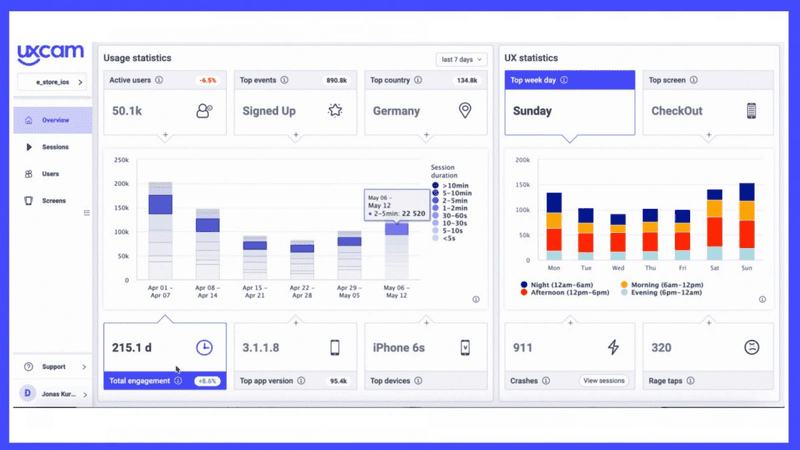
Start tracking smarter today
Mobile app tracking is powerful, but it only works if you’re intentional about it. That means instead of collecting random data that won’t reveal anything useful, you keep your analysis focused.
How?
By defining the key events you’re looking to track across the app journey. Using tools like heatmaps and session replays to understand behavior better. Analyzing funnels to see where users are dropping off, and applying cohort analysis to compare behavior changes over time. And always tailoring your tracking methods to your app’s use case and your users’ needs.
Ready to start mobile app tracking? Book a demo today and see how Userpilot can help you track behavior data for different segments and run various app analytics, without any coding.
FAQ
How do apps track users?
Both iOS and Android apps track users by:
- Capturing in-app events and user interactions: Includes clicks, form submissions, in-app purchases, frequency of specific actions, etc.
- Recording session flows: Includes navigation flows between screens and user paths to identify behavior patterns, bottlenecks, and friction areas.
- Tagging users with unique IDs or attributes: Assigns users identifiers like user IDs or device IDs, and tags them with attributes based on their demographics or behavior.
Can I track anonymous users in my mobile app?
Yes, most analytics tools let you track anonymous users by assigning a unique session or device ID. This lets you monitor behavior before signup or login, without collecting personal information.
What’s the difference between event tracking and session tracking?
Event tracking captures specific user actions on your website or app. Examples include “button clicked” or “purchase completed”.
In contrast, session tracking shows the entire path a user takes during a visit, including the starting point, sequence of actions taken, time spent, and exit point.
The two shouldn’t be confused with screen tracking, which only logs which screens or pages users viewed.



